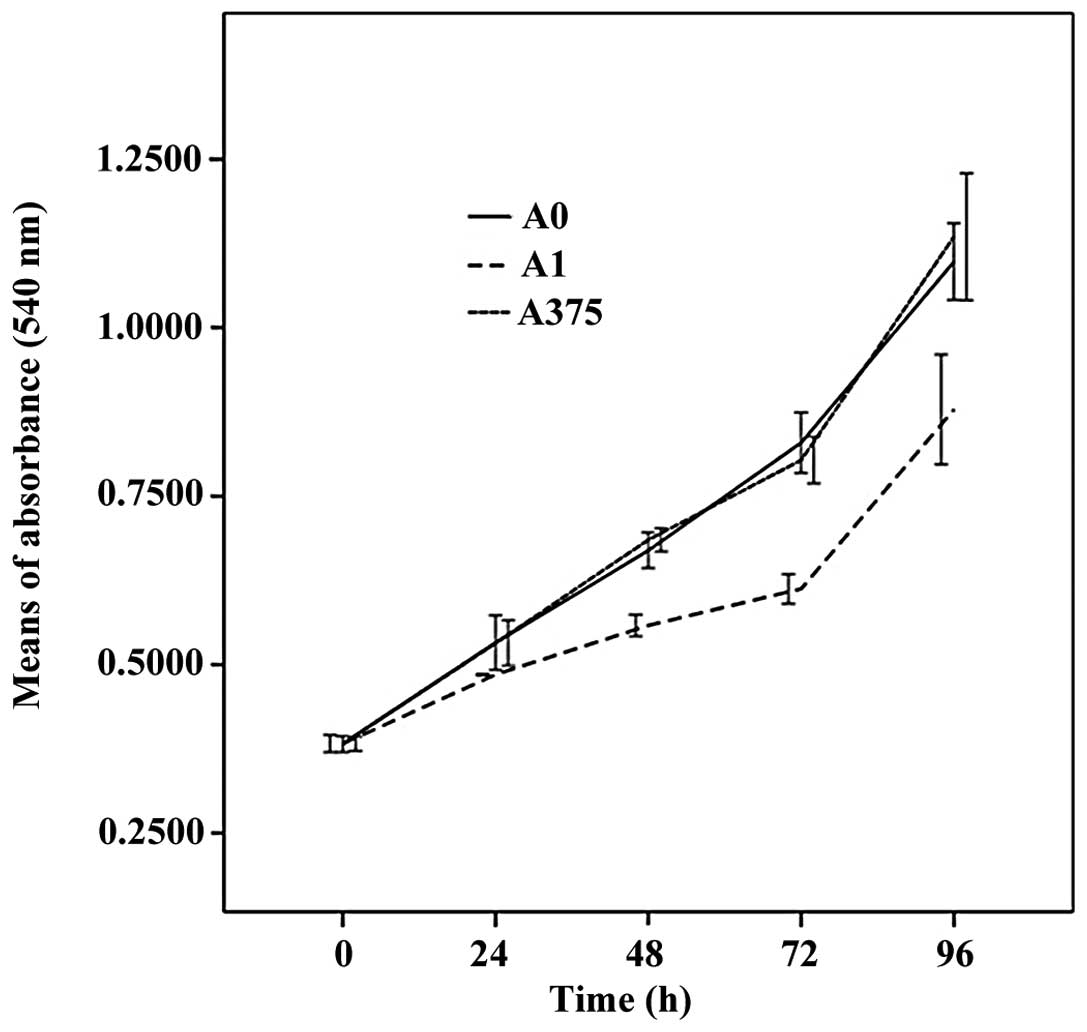|
1
|
Kuramochi M, Fukuhara H, Nobukuni T, et
al: TSLC1 is a tumor suppressor gene in human non-small cell lung
cancer. Nat Genet. 27:427–430. 2001. View
Article : Google Scholar : PubMed/NCBI
|
|
2
|
Uchino K, Ito A, Wakayama T, et al:
Clinical implication and prognostic significance of the tumor
suppressor TSLC1 gene detected in adenocarcinoma of the lung.
Cancer. 98:1002–1007. 2003. View Article : Google Scholar : PubMed/NCBI
|
|
3
|
Tamura G: Promoter methylation status of
tumor suppressor and Tumor related genes in neoplastic and
non-neoplastic gastric epithelia. Histol Histopathol. 19:221–228.
2004.PubMed/NCBI
|
|
4
|
Dewan MZ, Takamatsu N, Hidaka T, et al:
Critical role for TSLC1 expression in the growth and organ
infiltration of adult T-cell leukemia cells in vivo. J
Virol. 82:11958–11963. 2008. View Article : Google Scholar : PubMed/NCBI
|
|
5
|
Yang G, He W, Cai M, et al:
Loss/Down-regulation of tumor suppressor in lung cancer 1
expression is associated with tumor progression and is a biomarker
of poor prognosis in ovarian carcinoma. Int J Gynecol Cancer.
21:486–493. 2011. View Article : Google Scholar : PubMed/NCBI
|
|
6
|
Jansen M, Fukushima N, Rosty C, et al:
Aberrant methylation of the 5-CpG island of TSLC1 is common in
pancreatic ductal adenocarcinoma and is first manifest in
high-grade PanlNs. Cancer Biol Ther. 1:293–296. 2002. View Article : Google Scholar : PubMed/NCBI
|
|
7
|
Crawford NP, Qian X, Ziogas A, et al:
Rrp1b, a new candidate susceptibility gene for breast cancer
progression and metastasis. PLoS Genet. 3:e2142007. View Article : Google Scholar : PubMed/NCBI
|
|
8
|
You Y, Ma L, You M, et al: TSLC1 gene
silencing in cutaneous melanoma. Melanoma Res. 20:179–183.
2010.PubMed/NCBI
|
|
9
|
Herszényi L, Hritz I, Lakatos G, Varga MZ
and Tulassay Z: The behavior of matrix metalloproteinases and their
inhibitors in colorectal cancer. Int J Mol Sci. 13:13240–13263.
2012.PubMed/NCBI
|
|
10
|
Meyskens FL Jr, Farmer PJ, Yang S and
Anton-Culver H: New perspectives on melanoma pathogenesis and
chemoprevention. Recent Results Cancer Res. 174:191–195. 2007.
View Article : Google Scholar : PubMed/NCBI
|
|
11
|
Balch CM, Buzaid AC, Soong SJ, et al:
Final version of the American Joint Committee on Cancer staging
system for cutaneous melanoma. J Clin Oncol. 19:3635–3648.
2001.PubMed/NCBI
|
|
12
|
Takahashi Y, Iwai M, Kawai T, et al:
Aberrant expression of tumor suppressors CADM1 and 4.1B in invasive
lesions of primary breast cancer. Breast Cancer. 19:242–252. 2012.
View Article : Google Scholar : PubMed/NCBI
|
|
13
|
Heller G, Fong KM, Girard L, et al:
Expression and methylation pattern of TSLC1 cascade genes in lung
carcinomas. Oncogene. 25:959–968. 2006. View Article : Google Scholar : PubMed/NCBI
|
|
14
|
Houshmandi SS, Surace EI, Zhang HB, et al:
Tumor suppressor in lung cancer-1 (TSLC1) functions as a glioma
tumor suppressor. Neurology. 67:1863–1866. 2006. View Article : Google Scholar : PubMed/NCBI
|
|
15
|
Fukami T, Fukuhara H, Kuramochi M, et al:
Promoter methylation of the TSLC1 gene in advanced lung tumors and
various cancer cell lines. Int J Cancer. 107:53–59. 2003.
View Article : Google Scholar : PubMed/NCBI
|
|
16
|
Yamada D, Yoshida M, Williams YN, et al:
Disruption of spermatogenic cell adhesion and male infertility in
mice lacking TSLC1/IGSF4, an immunoglobulin superfamily cell
adhesion molecule. Mol Cell Biol. 26:3610–3624. 2006. View Article : Google Scholar : PubMed/NCBI
|
|
17
|
He G, Lei W, Wang S, et al: Overexpression
of tumor suppressor TSLC1 by a survivin-regulated oncolytic
adenovirus significantly inhibits hepatocellular carcinoma growth.
J Cancer Res Clin Oncol. 138:657–670. 2012. View Article : Google Scholar
|
|
18
|
Surace EI, Lusis E, Murakami Y, et al:
Loss of tumor suppressor in lung cancer-1 (TSLC1) expression in
meningioma correlates with increased malignancy grade and reduced
patient survival. J Neuropathol Exp Neurol. 63:1015–1027. 2004.
|
|
19
|
Chen K, Wang G, Peng L, et al: CADM1/TSLC1
inactivation by promoter hypermethylation is a frequent event in
colorectal carcinogenesis and correlates with late stages of the
disease. Int J Cancer. 128:266–273. 2011. View Article : Google Scholar : PubMed/NCBI
|
|
20
|
Ando K, Ohira M, Ozaki T, et al:
Expression of TSLC1, a candidate tumor suppressor gene mapped to
chromosome 11q23, is downregulated in unfavorable neuroblastoma
without promoter hypermethylation. Int J Cancer. 123:2087–2094.
2008. View Article : Google Scholar : PubMed/NCBI
|
|
21
|
Sussan TE, Pletcher MT, Murakami Y and
Reeves RH: Tumor suppressor in lung cancer 1 (TSLC1) alters
tumorigenic growth properties and gene expression. Mol Cancer.
4:282005. View Article : Google Scholar : PubMed/NCBI
|
|
22
|
Qin L, Zhu W, Xu T, et al: Effect of TSLC1
gene on proliferation, invasion and apoptosis of human
hepatocellular carcinoma cell line HepG2. J Huazhong Univ Sci
Technolog Med Sci. 27:535–537. 2007. View Article : Google Scholar : PubMed/NCBI
|
|
23
|
Mao X, Seidlitz E, Truant R, Hitt M and
Ghosh HP: Re-expression of TSLC1 in a non-small-cell lung cancer
cell line induces apoptosis and inhibits tumor growth. Oncogene.
23:5632–5642. 2004. View Article : Google Scholar : PubMed/NCBI
|
|
24
|
Giannelli G and Antonaci S: MMP and TIMP
assay in cancer: Biological and clinical significance. Int J
Cancer. 116:1002–1003. 2005. View Article : Google Scholar
|













